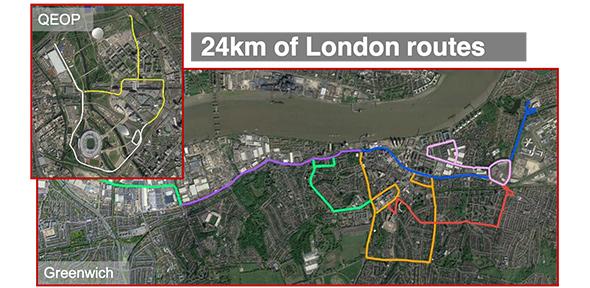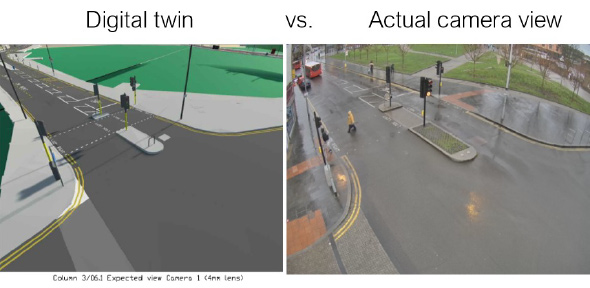
Submitted by Angela Walters on Wed, 17/03/2021 - 10:54
As transport systems increase in complexity and mutual dependency the cost and requirement for real-world testing is also increasing. Therefore, the automotive and transport industries are seeking to augment real-world testing with simulation and virtual analysis.
In the past, controlled environments such as MIRA and Millbrook were sufficient to test and develop road vehicles. However, modern road vehicles are increasingly connected and share information with other vehicles and with the infrastructure (traffic signals, roadside sensors) creating a highly complex system. While some of the components of these systems can still be tested in the laboratory or in controlled environments, testing the complete system can only be achieved through real world testing in a representative environment.
Smart Mobility Living Lab (SMLL) was developed to meet this need, it was part funded by industry and the Government via the Centre for Connected and Autonomous Vehicles and InnovateUK. The facility was designed and built by a consortium comprising TRL, Cisco, DG Cities, London Legacy Development Corporation, Cubic, Loughborough University and Transport for London.
Use cases and Challenges
The main drivers and challenges for the project were:
-
Virtual validation of transport solutions in order to reduce the cost of developing increasingly complex transport systems.
-
Building the SMLL was a significant construction challenge involving many stakeholders in a complex dynamic environment. The SMLL digital twin was developed from the BIM model to ensure correct design.
What is it?
The SMLL digital twin is a complete digital representation of the SMLL facility, where possible using open standards to ensure interoperability with customers and partners.
SMLL covers 24km of instrumented public roads in the Queen Elizabeth Olympic Park and the Royal Borough of Greenwich. The roads were selected for the diversity of features such as mini-roundabouts, junctions, crossings, schools, stadiums, traffic patterns and pedestrian movement. There is a private fibre network and over 200 monitoring sites with connectivity and sensing. The data is consolidated in two data centres with and control rooms with high performance computing capability. There are also vehicle workshops, electric vehicle charging facilities and several open architecture automated vehicles.
The SMLL digital twin combines historic information about incidents with dynamic data about traffic flows and pedestrian movement. This enables a system to be virtually tested against millions of scenarios in a safe and cost-effective manner using a range of simulation environments. Examples of the components can be found here
The SMLL enables the automotive/transport industry to validate the performance of their systems in both the real-world operating environment and a linked digital representation of it. This digital twin enables customers to both ensure safety and reduce the cost of bringing a product or service to market.
The SMLL digital twin supports a wide array of mechanisms for interacting with the data including: graphical interfaces within the simulation environments and in many instances the SMLL digital twin components will be integrated with components of the users’ digital representation of their product or service.
Key outcomes
Key outcomes to date include:
-
Supporting the safe construction of the SMLL testbed by reducing the need for repeat visits to site and a key ‘dig once’ principle
-
Fundamental input to the testbed design, enabling SMLL to identify support for specific customer projects whilst still building the test bed
-
Supporting safer societal outcomes by using the SMLL digital twin to develop and validate new technologies prior to their deployment in the real-world
Relationship with the Gemini Principles
|
Purpose |
Public Good |
Value Creation |
Insight |
|
|
Yes |
Yes |
Yes |
|
Trust |
Security |
Openness |
Quality |
|
|
Yes |
Partially |
Yes |
|
Function |
Federation |
Curation |
Evolution |
|
|
No |
Partially |
Yes (planned) |
Public Good
TRL’s mission is to create clean and efficient transport that is safe, reliable and accessible for everyone. It is a non-profit distributing foundation.
The rationale for building the SMLL, and the digital twin behind it, was to answer the need for virtual testing and to have a positive impact on the place in which testing occurs. The London Legacy Development Corporation at the Queen Elizabeth Olympic Park and Royal Greenwich Council are engaged with local job development and inward investment initiatives to de-risk the Thamesmead development.
Value Creation
SMLL is a testbed facility and service which testers pay for. The digital twin is used in both the design, build and operation of the facility, and also underpins the simulation proposition that SMLL offers to customers. The digital twin is made available to SMLL’s clients to enable them to optimise the efficiency of their development and testing activities.
Insight (Must provide determinable insight into the built environment)
SMLL provides input for the enterprises testing technology and also the communities which will use and accommodate it. The SMLL digital twin incorporates accurate representation of the testbed’s physical environment. It also includes content relating to the dynamic activities around the testbed such as traffic movements, traffic signal control scenarios, scenario capture, and content feeds.
Security
The digital element of SMLL is a closed system with security measures in place.
Openness
Physical testing is conducted in the open with active engagement. The digital element is made available to SMLL’s clients either as part of its testing proposition or as part of SMLL’s simulation proposition which utilises the digital twin to deliver content and host simulation services.
Quality
Quality of the data is controlled by the sensors which are part of the SMLL system and the testing element.
Federation
There is no federation of the data at this point, however this could be explored in the future.
Curation
Currently the data is curated only because input is limited.
Evolution
It is anticipated that SMLL will further develop in the future to respond to market developments and client needs, technological change, and evolving regulatory and certification regimes.
Conclusions
SMLL represents a new and nimble sort of digital twin applied to a particular sector and the application of new technology.


